National Gallery of Canada
The National Gallery of Canada (French: Musée des beaux-arts du Canada), located in the capital city of Ottawa, Ontario, is Canada's national art museum.[7] The museum's building takes up 46,621 square metres (501,820 sq ft), with 12,400 square metres (133,000 sq ft) of space used for exhibiting art; making the museum one of the largest art museums in North America by exhibition space.
 | |

| |
| Established | 1880 |
|---|---|
| Location |
|
| Coordinates | 45°25′46″N 75°41′54″W |
| Type | Art museum |
| Collection size | 93,625[1] |
| Visitors | 385,576 (2017–18)[2] |
| Director | Alexandra Suda |
| Curator | Kitty Scott (Chief Curator) |
| Architect | Moshe Safdie (1983)[3][4][5] |
| Public transit access | 9 Rideau/Hurdman |
| Website | www |
The institution was established in 1880 at the Second Supreme Court of Canada building, and moved to the Victoria Memorial Museum building in 1911. In 1913, the Government of Canada passed the National Gallery Act, formally outlined the institution's mandate as a national art museum. The museum was moved to the Lorne building in 1960. In 1988, the museum was relocated to its present location. The National Gallery of Canada is presently situated in a glass and granite building on Sussex Drive with a notable view of the Canadian Parliament buildings on Parliament Hill. The building was designed by Moshe Safdie and opened in 1988.[3][4][5][8]
The museum's permanent collection includes over 93,000 works from European, American, and Asian, Canadian, and indigenous Canadian artists. In addition to exhibiting works from its permanent collection, the museum also organizes and hosts a number of travelling exhibitions.
History

The Gallery was first formed in 1880 by Canada's Governor General, John Campbell, 9th Duke of Argyll in conjunction with the establishment of the Royal Canadian Academy of Arts. In 1882, moved into its first home on Parliament Hill, housed in the Second Supreme Court of Canada building.[8]
Eric Brown was named the first director in 1910.[9] In 1911, the Gallery moved to the Victoria Memorial Museum building, sharing it with the National Museum of Natural Sciences. In 1913, the first National Gallery Act was passed, outlining the Gallery's mandate and resources.[8] During the 1920s, the building was expanded, which saw the art gallery expand to four floors, and the creation of a separate entrance for the art museum, and a firewall between the natural sciences museum, and the National Gallery.[10] However, as with the Supreme Court building, its location in the Victoria Memorial Museum building was viewed as a "temporary space," with plans to eventually move to a new permanent location, with spaces dedicated to the viewing of art.[10]
.jpg)
By the 1950s, the space in the Victoria Memorial Museum building had grown inadequate for the museum's collections. In 1952, the museum launched a design contest for architects to design a permanent home for the gallery.[10] However, the museum failed to garner support from the government of Louis St. Laurent, resulting in the winning bid to eventually be abandoned by the museum.[10] In an effort to provide a workable compromise for the National Gallery, St. Laurent's government offered the National Gallery the eight-storey Lorne office building for use.[10] The National Gallery moved into the nondescript office building on Elgin Street.[11] The building has since been demolished for a 17-storey office building that is to house the Federal Finance Department.
In 1962, the museum's director, Charles Comfort, drew criticism after half of the works on display at an exhibition for Walter Chrysler's European works were exposed as forgeries by American journalists. Comfort allowed for the exhibition to be hosted at the museum in spite of receiving advanced warning from the director of the Montreal Museum of Fine Arts.[12]
The National Museums of Canada (NMC) absorbed the National Gallery of Canada in 1968.[13] During the 1970s, the National Gallery saw its funds diverted by the NMC to form regional galleries.[13] The museum completed renovations to the Lorne building in 1976.[10] However by 1980, it had become apparent that the National Gallery would need to relocate from the building, given the poor condition of the building, use of asbestos in the building, and inadequate exhibition areas that only provided the museum enough space to only exhibit two per cent of its collection at any given time.[10]
After the Canadian constitution was patriated in 1982, Prime Minister Pierre Trudeau announced a shift in policy focus towards the "creation of a nation," with priority given towards the arts in an effort to enrich Canadian identity.[10] In same year, Minister of Communications Francis Fox declared the government's commitment to erect a new permanent buildings for its national museums, including the National Gallery, and the Museum of Man within five years.[13] The director of the National Gallery, Jean Sutherland Boggs, was chosen by Trudeau to oversee construction of the national gallery and museums.[14] The museum began construction for its permanent museum building on Sussex Drive in 1985, and was opened in May 1988.[15]
The diversion of funds by the NMC to help fund regional museums was ended in 1982,[16] and the National Museums of Canada formally dissolved in 1987.[15] As a result of the dissolution, the National Gallery reacquired its institutional independence, and its mandate and powers outlined by its formative legislative act prior to 1968.[15]
In 1985, the newly created Canadian Museum of Contemporary Photography (CMCP), formerly the Stills Photography Division of the National Film Board of Canada, was affiliated to the National Gallery. The CMCP's mandate, collection and staff moved to its new location in 1992, at 1 Rideau Canal, next to the Château Laurier. In 1988, the CMCP's administration was amalgamated to that of the National Gallery's. The museum operated until 2006, with its collection was absorbed into the National Gallery's in 2009.
In December 2009, the National Gallery of Canada and the Art Gallery of Alberta issued a joint press release announcing a three-year partnership, which saw the use of the Art Gallery of Alberta's galleries to exhibit works from the National Gallery's collection.[17] The program was the first "satellite program" between the National Gallery of Canada, and another institution, with similar initiatives launched in other Canadian art galleries in the following years.[17]
Marc Mayer was named the museum's director, succeeding Pierre Théberge, on 19 January 2009.[18] On 19 April 2019, he was succeeded by Alexandra Suda, who was appointed the 11th Director and Chief Executive Officer of the National Gallery of Canada.
Directors
The following is a list of directors of the National Gallery of Canada (excluding interim "acting" directors):
- Eric Brown (1910–1939)[19]
- Harry Orr McCurry (1939–1955)[19]
- Alan Jarvis (1955–1959)[19]
- Charles Comfort (1960–1965)[19]
- Jean Sutherland Boggs (1966–1976)[16]
- Hsio-yen Shih (1977–1981)[20]
- Joseph Martin (1983–1987)[21][note 1]
- Shirley Thomson (1987–1997)[22]
- Pierre Théberge (1998–2008)[23]
- Marc Mayer (2009–2019)[24]
- Alexandra Sasha Suda (2019–present)[24]
Architecture
The National Gallery of Canada is presently housed in a building on Sussex Drive, adjacent to the ByWard Market district. The building is the fourth edifice to house the art museum. The museum's present building was designed by Moshe Safdie & Associates, with construction beginning in 1985, and the building opening in 1988. The building has a total floor area of 46,621 square metres (501,820 sq ft). In 2000, the Royal Architectural Institute of Canada chose the National Gallery as one of the top 500 buildings produced in Canada during the last millennium.[25]
An independent crown corporation, the Canadian Museums Construction Corporation was established to build the museum with a budget of C$185 million.[16] Following the 1984 Canadian federal election, Prime Minister Brian Mulroney dissolved the corporation.[15] However, because the groundwork for the building was already completed, Mulroney chose to continue funding construction for the museum, albeit at a reduced total budget of C$162 million.[15]
Exterior
.jpg)
The building's northern, eastern, and western exterior facade is made up of pink-granite walls, or glass-windows.[26] The southern exterior facade features an elongated glass wall, supported by concrete pylons grouped in fours.[26] The profile of the southern facade was designed to mimic a cathedral, with the concrete pylons being used in a similar manner to the flying buttresses found on Gothic cathedrals.[26] The eastern portion of the building's southern facade transitions into a low-leveled crystalline glass-cupola, which holds the museum's main entrance; and its western portion, which features a three-tiered glass-cupola.[26]
The three tiered glass-cupola is formed out of rectangular glass and narrow steel supports.[27] The second tier of the cupola is formed out of rectangles and equilateral triangles that are further subdivided into eight or twelve smaller equilateral triangles.[28] All these glass pieces are joined together by steel struts. The third tier of the cupola is formed with similar designs, although the triangular glass panes are isosceles triangles.[28] The isosceles triangles converge upwards, with its apexes towards the centre.[28] The building's three-tiered cupola is positioned in a manner in which the cupola would be flanked by the Peace Tower and the Library of Parliament to the west, when approaching the museum from the east.[29]
Interior
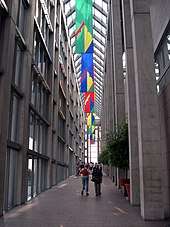
The interior entrance lobby is floored with pink-granite, and included a straight four metres (13 ft) wide ramp which slopes upward towards the west.[30] Safdie noted the importance of the ramp in his design, stating that one should "go through some kind of procession to make your way into something s important as the National Gallery," and that it gave the visitor the feeling of making an ascent to a ritual, a ceremony.[31] The walls of the entrance lobby is lined with rectangular cut pink granite, excluding the southern wall, which part of the glass-walled exterior facade.[32] A glass and steel ceiling reminiscent of Gothic cathedral architecture, extends the entire way of the ramp.[32] However, as opposed to most Gothic cathedrals, the ceiling has a number of concrete columns spaced out to support the roof.[32] The summit of the ramp leads towards the Great Hall of the building, situated in the three-storey glass cupola.[27]
The interior courtyard of the building includes the Taiga Garden. The garden was designed by Cornelia Oberlander, who modelled it the painting Terre Sauvage by A. Y. Jackson;[33] a painting in the National Gallery's permanent collection. The garden attempts to mimic the landscape depicted in the painting, the Canadian shield; although substitutes limestone is substituted in place of the granite typically found at the Canadian shield.[33]
Collection
As of October 2018, the National Gallery of Canada permanent collection holds over 93,625 works,[1] representing a number of artistic movements and eras in art history. The Gallery has a large and varied collection of paintings, drawings, sculpture and photographs. The earliest works acquired by the museum were from Canadian artists, with Canadian art remaining the focus for the institution. However, its collection also includes a number of works from artists around the world. The museum's collection has been built up through purchase and donations. The museum organizes its own travelling exhibitions to exhibit its collection, travelling across Canada and abroad.[34][35] The National Gallery is the largest lender of artwork in Canada, sending out approximately 800 pieces a year.[36]
The museum's prints and drawings collection includes 27,000 works on paper dating from the 15th century to the present. The prints and drawing collection includes 10,000 works on paper by Canadian artists; more than 800 of these prints and drawings being crafted by Inuit artists.[37] The prints and drawing collection also includes 2,500 drawings and 10,000 prints by American, Asian, and European artists.
The museum also has approximately 400 works from Asian artists, dating from the 200 CE to 19th century. The museum's Asian collection began in the early 20th century, with a number of works originating from the collection of Nasli Heeramaneck.[38] The museum's also has a collection of photographs, maintained as the Canadian Photography Institute. A number of the photographs in the collection originated from the defunct Canadian Museum of Contemporary Photography.
The largest work in the Gallery is the entire interior of the Rideau Street Chapel, which formed part of the Convent of Our Lady Sacred Heart,[11] The interior decorations of the Rideau Street Chapel were designed by Georges Couillon in 1887.[9] The chapel interior was acquired by the musum in 1972, when the convent was slated for demolished. The interior's 1,123 pieces was dismantled, stored and reconstructed within the gallery as a work of art in 1988.[9]
Canadian and indigenous
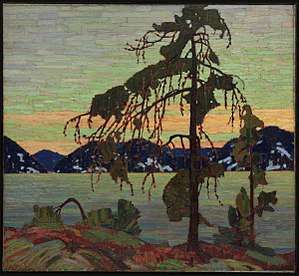
The museum's Canadian collection includes works dating from 18th century New France, to the 1990s.[39] The collection includes paintings from pre-Confederation; abstract paintings and other postwar art; and the Henry Birks Collection of Canadian Silver.[39] Early pre-Confederation paintings were among the first items in the Canadian collections, with the National Gallery's earliest works originating from Canadian artists at the Royal Canadian Academy of Arts.[39]
The museum's Canadian collection holds a large number of works by the Group of Seven.[39] The museum also holds a large collection of Tom Thomson works,[39] with the museum adding The Jack Pine to its collection in 1918.[40] The museum also holds the largest collection of works by Alex Colville.[41] Other artists featured in the collections includes William Berczy, Jack Bush, Paul-Émile Borduas, Emily Carr, Robert Field, Vera Frenkel, Theophile Hamel, Joseph Légaré, Cornelius Krieghoff, Fernand Leduc, Alexandra Luke, Ken Lum, James Wilson Morrice, John O'Brien, Antoine Plamondon, William Raphael, Jean-Paul Riopelle, William Ronald, Michael Snow, Lisa Steele, Jeff Wall, Joyce Wieland, Paul Wong, and members of the Regina Five.[39][40]
In commemoration of the 150th anniversary of Canada in 2017, the museum of undertook a C$7.4 million renovation to open the Canadian and Indigenous Art: From Time Immemorial to 1967 gallery.[42] The gallery exhibits the progression of Canadian art and history, exhibiting Canadian and indigenous Canadian works side-by-side.[42] These works are exhibited in a manner which examines the intertwined relations between the two groups of people.[42]
.jpg)
The indigenous collection includes works by indigenous artists around the world, although it has an emphasis on works by the indigenous peoples of Canada. The museum collection acquired its first works by First Nations and Metis artists in the early 20th century.[43] The museum acquired its first Inuit works in 1956, crafted by artists in Nunavik.[37] In 1979, Henry Birks bequeathed a number of works from indigenous Canadian artists to National Gallery.[43] In 1989 and 1992, the Department of Indian Affairs and Northern Development bequeathed 570 works by Inuit artists.[37]
A number of Indigenous Canadian artists whose works are featured in the collection include Kenojuak Ashevak, Kiawak Ashoona, Qaqaq Ashoona, Carl Beam, Faye HeavyShield, Osuitok Ipeelee, Rita Letendre, Norval Morrisseau, Shelley Niro, David Ruben Piqtoukun, Abraham Anghik Ruben, Lucy Tasseor Tutsweetok, Jeffrey Thomas, John Tiktak, and Lawrence Paul Yuxweluptun.[40][43][37]
Contemporary
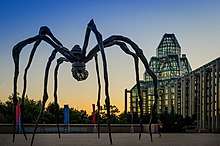
The museum's contemporary collection includes 1,500 works from artists since the 1990s.[44] The contemporary collection features a number of works from Canadian, and indigenous Canadian artists. The first indigenous Canadian contemporary artwork acquired by the National Gallery was in 1987, a piece by Anishinaabe artist Carl Beam. In 2017, Bob Rennie donated a contemporary art collection to the National Gallery in honour of Canada' 150th anniversary.[36] The collection includes 197 paintings, sculptures, and mixed-media pieces with most of it originating from Vancouver-based artists including Geoffrey Farmer, Rodney Graham, Brian Jungen, Ian Wallace.[36] However, the Rennie collection does include some international contemporary works, including from Doris Salcedo.[36]
In 1990 the Gallery bought Barnett Newman's Voice of Fire for $1.8 million, igniting a storm of controversy. However, since that time its value has appreciated to approximately C$40 million as of 2014.[40] In 1999, the museum acquired a sculpture a giant spider, Maman, by Louise Bourgeois for a cost of C$3.2 million.[40][45] The sculpture was installed in the plaza in front of the Gallery.[40] In 2011 the gallery installed Canadian sculptor Joe Fafard's Running Horses next to the Sussex Drive entrance, and American artist Roxy Paine's stainless steel sculpture One Hundred Foot Line in Nepean Point behind the gallery. Other contemporary artists whose works are featured in the National Gallery's collection includes David Altmejd, Lee Bul, Janet Cardiff, Bharti Kher, Christian Marclay, Elizabeth McIntosh, Chris Ofili, Roxy Paine, Ugo Rondinone, and Joanne Tod.[44]
European, American, and Asian
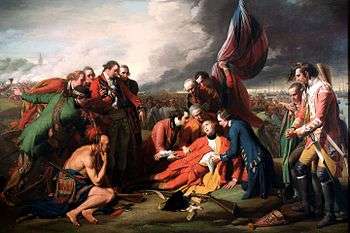
The European, American, and Asian collection area includes most of the museum's works by non-Canadian artists. The museum acquired its first European work in 1907, the painting "Ignatius Sancho" by Thomas Gainsborough.[46] Conversely, the museum did not begin to develop its collection of American art until the 1970s.[46] The museum's collection presently includes American and European works dating from the Renaissance through to the 20th century.[46] In addition to Western art, the collection area also has 400 works from India, Nepal, and Tibet.[47]
The museum European collection has since expanded either through acquisitions or gifts. Works acquired through acquisitions include La Tour Eiffel by Marc Chagall, acquired by the museum in 1956 for $C16,000.[48] In 2018, the museum planned to sell the piece to fund acquisitions of other works, but abandoned those plans after it was found to be unpopular with the public.[48] In 2005, the Gallery acquired a painting by Italian Renaissance painter Francesco Salviati for $4.5 million.[49] In 2018, the museum acquired The Partie Carée by James Tissot from the collection of David R. Graham, putting it on display in December 2018.[50] It is the third work by Tissot to be acquired by the museum since 1921.[50] Other works from the collection include The Death of General Wolfe by Anglo-American artist Benjamin West.[40] Other artists featured in the museum's European collection includes Alejo Fernández, Vilhelm Hammershøi, Gustav Klimt, Élisabeth Vigée Le Brun, Henri Matisse, Charles Meynier, Claude Monet, Rembrandt, and Vincent van Gogh.[40][38]
Library and Archives
The Library and Archives of the National Gallery of Canada holds an extensive collection of art literature on Canadian art.[51] The library and archives was established alongside the museum in 1880, and contains documents on western art from the Late Middle Ages to the present.[51] The collection includes 275,000 books, exhibition catalogues, and periodicals; 76,000 documentation files; and 95,000 microforms.[51] The archives serves as the institutional archive for the museum.
The Library and Archives' Special Collections includes over 50,000 auction catalogues, in addition to 182,000 slides and 360,000 research photographs.[52] The Library and Archives' Exceptional Materials and Notable Subject Collections contains a number of rare imprints, books, and bookplates on Canadian artists, as well as items relating to historians of Canadian art.[52]
Affiliations
The museum is affiliated with several associations, including the Canadian Museums Association, the Ontario Association of Art Galleries, the Canadian Heritage Information Network, and the Virtual Museum of Canada.
Selected works
Canadian collection
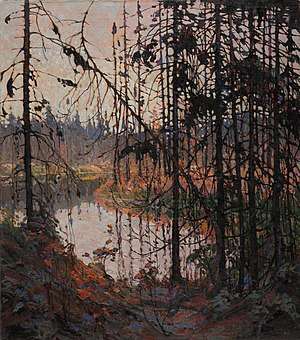 Tom Thomson, Northern River, 1914–15
Tom Thomson, Northern River, 1914–15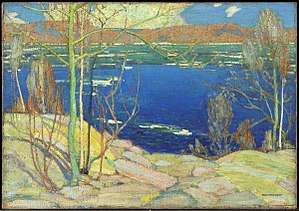 Tom Thomson, Spring Ice, 1915–16
Tom Thomson, Spring Ice, 1915–16 Tom Thomson, The Jack Pine, 1916–17
Tom Thomson, The Jack Pine, 1916–17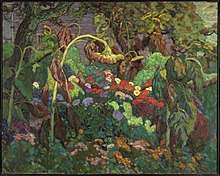 J. E. H. MacDonald, The Tangled Garden, 1916
J. E. H. MacDonald, The Tangled Garden, 1916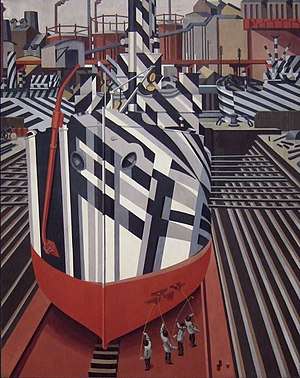
 David Milne, Vimy Ridge from Souchez, Estaminet among the Ruins, 1919
David Milne, Vimy Ridge from Souchez, Estaminet among the Ruins, 1919 Franklin Carmichael, The Upper Ottawa, near Mattawa, 1924
Franklin Carmichael, The Upper Ottawa, near Mattawa, 1924 Bill Vazan, Black Nest, 1989–91
Bill Vazan, Black Nest, 1989–91
European and American collection
- Auguste Rodin, Age of Bronze, 1875–1876, cast in 1901
- M. C. Escher, Stars, 1948
- Barnett Newman, Voice of Fire, 1967
 Hieronymus Bosch, The Temptation of St. Anthony, 1501–50
Hieronymus Bosch, The Temptation of St. Anthony, 1501–50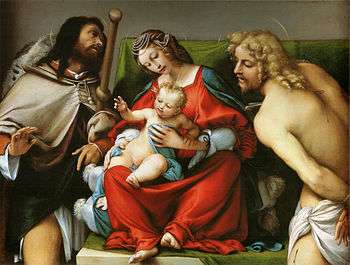
%2C_Daniele_Barbaro%2C_1545._National_Gallery_of_Canada.jpg) Titian, Daniele Barbaro, 1545
Titian, Daniele Barbaro, 1545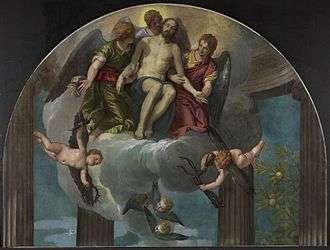
 El Greco, St. Francis and Brother Leo Meditating on Death, c. 1600–05
El Greco, St. Francis and Brother Leo Meditating on Death, c. 1600–05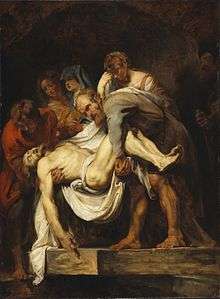 Peter Paul Rubens, The Entombment, c. 1612–15
Peter Paul Rubens, The Entombment, c. 1612–15 Rembrandt, Heroine from the Old Testament, 1632–33
Rembrandt, Heroine from the Old Testament, 1632–33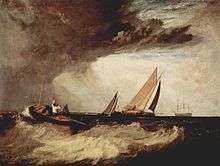 J. M. W. Turner, Shoeburyness Fishermen Hailing a Whitstable Hoy, c. 1809
J. M. W. Turner, Shoeburyness Fishermen Hailing a Whitstable Hoy, c. 1809 Honoré Daumier, The Third-Class Carriage, 1863–65
Honoré Daumier, The Third-Class Carriage, 1863–65.jpg) Paul Gauguin, The Quarries of Le Chou near Pontoise, 1882
Paul Gauguin, The Quarries of Le Chou near Pontoise, 1882 Vincent van Gogh, Iris, 1890
Vincent van Gogh, Iris, 1890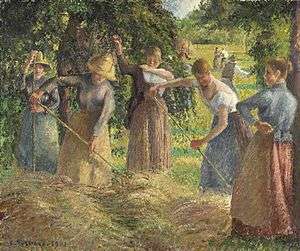
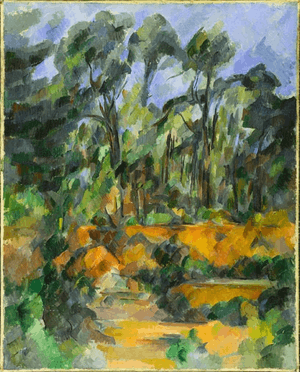
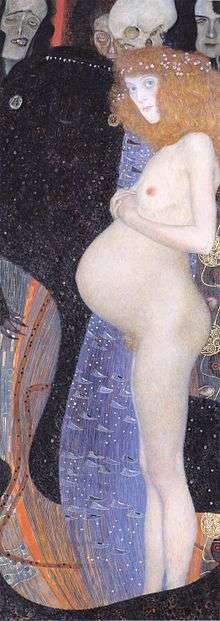 Gustav Klimt, Hope I, 1903
Gustav Klimt, Hope I, 1903 Arshile Gorky, Charred Beloved II, 1946
Arshile Gorky, Charred Beloved II, 1946
Prints and drawings collection
 Giorgio Vasari, Abraham and the Three Angels, c. 16th century
Giorgio Vasari, Abraham and the Three Angels, c. 16th century Caspar David Friedrich, Boy Sleeping on a Grave, c. 1801–03
Caspar David Friedrich, Boy Sleeping on a Grave, c. 1801–03 Eugène Delacroix, The Barque of Dante, c. 1820
Eugène Delacroix, The Barque of Dante, c. 1820 Francisco Goya, Holy Week in Spain in Times Past, c. 1825
Francisco Goya, Holy Week in Spain in Times Past, c. 1825 Ford Madox Brown, Portrait of Emma Madox Brown, 1853
Ford Madox Brown, Portrait of Emma Madox Brown, 1853 John Everett Millais, Portrait of Effie Ruskin, c. 1853
John Everett Millais, Portrait of Effie Ruskin, c. 1853 Odilon Redon, The Raven, 1882
Odilon Redon, The Raven, 1882 Mary Cassatt, Woman Bathing, c. 1890–1891
Mary Cassatt, Woman Bathing, c. 1890–1891
Notes
- Martin was named the "acting director" of the institution since 1981, although he was not conferred as the institution's formal director until August 1983.[21]
References
- "Search the Collection". Gallery.ca. Retrieved 30 May 2019.
- "Corporate Performance" (PDF). National Gallery of Canada Annual Report 2017–2018. National Gallery of Canada. p. 47.
- "National Gallery of Canada". SkyscraperPage.
- National Gallery of Canada at Emporis
- National Gallery of Canada at Structurae
- "O-Train Confederation Line: Rideau". LigneConfederationLine.ca. City of Ottawa. 2019. Retrieved 30 May 2019.
- The Canadian Encyclopedia Archived 2009-02-13 at the Wayback Machine
- National Gallery of Canada – 1980 Archived 2010-09-19 at the Wayback Machine
- "Architectural Interiors". gallery.ca. National Gallery of Canada. 2019. Retrieved 10 October 2019.
- Ord 2003, p. 12.
- Pound, Richard W. (2005). 'Fitzhenry and Whiteside Book of Canadian Facts and Dates'. Fitzhenry and Whiteside.
- Fulford, Robert (9 September 2003). "Turning the absurd into an art form: Canada's National Gallery has a history filled with bizarre decisions". The National Post. Canwest. Retrieved 9 October 2019.
- Ord 2003, p. 13.
- "Concordia university to award five honorary degrees at five ceremonies for 3300 graduating students". Concordia University.
- Ord 2003, p. 17.
- Ord 2003, p. 15.
- Whitelaw, Anne (2017). Spaces and Places for Art: Making Art Institutions in Western Canada, 1912-1990. McGill-Queen's University Press. p. 265. ISBN 0-7735-5032-1.
- "Mayer confirmed as gallery director" Archived 2008-12-15 at the Wayback Machine, The Globe and Mail, 8 December 2008.
- Lerner, Mary F.; Williamson, Loren Ruth (1991). Art Et Architecture Au Canada. University of Toronto Press. p. 340. ISBN 0-8020-5856-6.
- Whitelaw, Anne (2017). Spaces and Places for Art: Making Art Institutions in Western Canada, 1912-1990. McGill-Queen University Press. p. 238. ISBN 0-7735-5032-1.
- Ord 2003, p. 349.
- "Former National Gallery head Shirley Thomson dies". CBC Arts. Canadian Broadcasting Corporation. 11 August 2010. Retrieved 3 March 2020.
- "Pierre Théberge, former Director of the National Gallery of Canada, will be fondly remembered for bringing the iconic sculpture Maman to the Gallery". www.gallery.ca. National Gallery of Canada. 9 October 2018. Retrieved 3 March 2020.
- Hum, Peter (13 February 2019). "Meet the National Gallery of Canada's new director: 'What's good for art is good for Canada and for the world'". Ottawa Citizen. Postmedia Network Inc. Retrieved 3 March 2020.
- Cook, Marcia (11 May 2000). "Cultural consequence". Ottawa Citizen. Canwest. Archived from the original on 30 May 2010. Retrieved 2009-10-11.
- Ord 2003, p. 5.
- Ord 2003, p. 27.
- Ord 2003, p. 28.
- Ord 2003, p. 6.
- Ord 2003, p. 19.
- Ord 2003, p. 21.
- Ord 2003, p. 22.
- Ord 2003, p. 23.
- National Gallery of Canada: Past Exhibitions Archived 2007-08-19 at the Wayback Machine
- National Gallery of Canada: Travelling Exhibitions Archived 2007-08-18 at the Wayback Machine
- Ditmars, Hadini (9 May 2017). "National Gallery of Canada receives major gift of contemporary art from collector Bob Rennie". The Art Newspaper. Retrieved 10 October 2010.
- "Inuit Art". gallery.ca. National Gallery of Canada. 2019. Retrieved 11 October 2019.
- "Asian Paintings and Sculptures". gallery.ca. National Gallery of Canada. 2019. Retrieved 10 October 2019.
- "Canadian Art". gallery.ca. National Gallery of Canada. 2019. Retrieved 10 October 2019.
- Boswell, Randy (3 November 2018). "Pricing 10 of the priceless: Here are some of the National Gallery of Canada's most expensive artworks (we think)". Ottawa Citizen. Postmedia Network Inc. Retrieved 10 October 2019.
- Reid, Robert (23 August 2014). "Alex Colville appreciated but not always understood". The Waterloo Region Record. Metroland Media Group. Retrieved 11 October 2019.
- Whyte, Murray (5 June 2017). "The National Gallery's moment of truth". Toronto Star. Torstar Corporation. Retrieved 10 October 2019.
- "Aboriginal Art". gallery.ca. National Gallery of Canada. 2019. Retrieved 11 October 2019.
- "Contemporary Art". National Gallery of Canada. 2019. Retrieved 10 October 2019.
- National Gallery of Canada is latest major museum to welcome Louise Bourgeois' Maman Archived 2009-09-25 at the Wayback Machine, 9 May 2005
- "European Art". gallery.ca. National Gallery of Canada. 2019. Retrieved 10 October 2019.
- "Asian Painting and Sculpture". gallery.ca. National Gallery of Canada. 2019. Retrieved 10 December 2019.
- Beeby, Dean (28 June 2018). "Gallery officials knew selling the Chagall would be highly controversial — but did it anyway". CBC News. Canadian Broadcasting Corporation. Retrieved 10 October 2019.
- National Gallery acquires rare Renaissance masterpiece by Salviati Archived 2007-07-14 at the Wayback Machine, 15 August 2005
- Hum, Peter (12 December 2018). "National Gallery of Canada acquires and exhibits 19th century French 'masterpiece'". Ottawa Citizen. Postmedia Network Inc. Retrieved 10 October 2019.
- "Library & Archives". National Gallery of Canada. 2019. Retrieved 1 December 2019.
- "Special Collections". National Gallery of Canada. 2019. Retrieved 1 December 2019.
Further reading
- Newsland, Anne (1991). "The National Gallery of Canada's Theme Rooms: Exploring the Educational Exhibition". Canadian Journal of Education. 16 (3): 361–370.CS1 maint: ref=harv (link)
- Ord, Douglas (2003). The National Gallery of Canada: Ideas, Art, Architecture. McGill-Queen's Press. ISBN 0-7735-2509-2.CS1 maint: ref=harv (link)
External links
| Wikimedia Commons has media related to National Gallery of Canada. |
- Official website

- National Gallery of Canada at Emporis
- "National Gallery of Canada". SkyscraperPage.
- National Gallery of Canada at Structurae